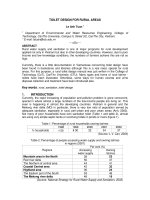Organization Design For Startups
Bạn đang xem bản rút gọn của tài liệu. Xem và tải ngay bản đầy đủ của tài liệu tại đây (106.17 KB, 3 trang )
jo aquinro ca.co m http://jo aquinro ca.com/2013/03/organization-design-for-startups/
Organization Design For Startups
Joaquin
inShare11
What is organization design?
When thinking about organization design, there are two aspects to concentrate on: the
architecture, which f ormally def ines authority and the division of labor (of ten represented by
an org chart); and operational processes, which def ine how shit gets done (of ten called
Standard Operating Procedures or SOPs).
Formal vs. Informal Design
Formal architecture comes f rom a need f or clarity around decision making, roles, responsibility, and
authority; creating too much f ormality in the architecture can lead to less f lexibility and a reliance on titles
and positional power, as opposed to ideas and knowledge, in decision making. The need f or clarity
around problem solving, collaboration, and communication leads to f ormal operational processes which
can reduce ambiguity and create more predictable results. Operational processes that are too f ormal,
however, can erect barriers to creativity, create bureaucracy, and lead to less coordination across the
organization.
A Model f or Organization Design
Crossing (f ormal and inf ormal) process with (f ormal and inf ormal) architecture creates a grid of f our
types of organizations I’ve named the Hive, the Forest, the Fractal, and the Sandbox. Curious where your
organization f its in? Take this assessment.
Organization Design for Startups
Startups begin in the sandbox. As they grow and f eel the need f or more structure, they of ten f ormalize
their architecture instead of clarif ying their process; by creating titles and reporting structures in the
hopes of clarif ying how shit gets done, they move towards the f orest. While their need is greater clarity
with regards to decision making, role authority, and responsibilities, they create titles titles and reporting
structures in the hope that architecture will clarif y process. This is a mistake and leads to prematurely
hierarchical organizations.
An alternative is to do what we did at SumAll. Instead of moving toward the f orest, move toward the
f ractal: clarif y processes while keeping the architecture lightweight. You can achieve this by clearly
delineating individual authority, roles, and responsibilities without assigning titles or creating reporting
relationships. In this way processes help structure how work gets done while the architecture remains
f airly inf ormal. Fractal designs keep organizations relatively f lat and f ree of artif icial power structures.
Creating a f latter organization empowers people throughout the organization to make decisions based
on their expertise, experience, and the strength of their ideas, not their hierarchical position.
Organization Design at Scale
The question is, can an organization remain a f ractal at scale? That really depends on the culture and
management. If the organization cannot, the best way to manage a more complex system of
relationships is to move to the hive, by creating clear lines of authority. Managing complexity through
greater architecture, however, means less f lexibility. The trick is to layer on as little f ormal architecture as
possible while supporting it with operational processes that make it easier to coordinate and collaborate.
The danger with operational processes, of course, is the creation of bureaucratic procedures that inhibit
coordination and collaboration. At each stage of growth you have to determine the minimal structural
requirements necessary to manage your organization’s complexity.
Remember to take the assessment and leave your thoughts below about the type of organization you
work in.
Comment on Hacker News
inShare11









